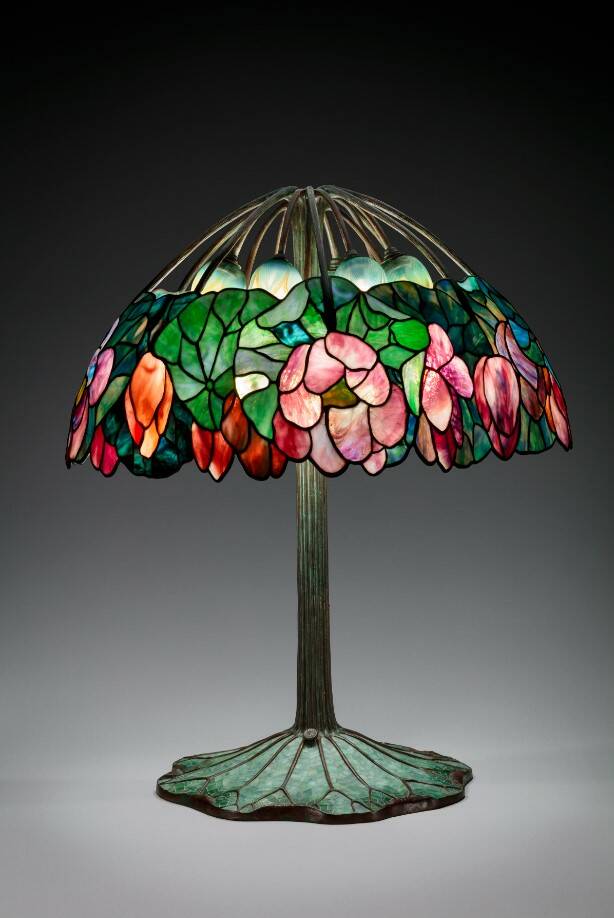
At 34 inches tall and 28 inches in diameter, the Lotus Lamp is the only known design that combines a leaded shade, an elaborate mosaic base, open work in bronze and individually blown favrile (or handmade) shades. (supplied photo)
TOLEDO – The Toledo Museum of Art continues to expand its growing collection with superlative artworks.
Among the most recent acquisitions is Tiffany Studios’ Lotus Lamp (ca. 1905), one of the manufacturer’s largest and most sophisticated designs. Created by more than a dozen skilled designers, glass selectors and cutters and glaziers, the wonderful example of American design in glass was also documented as Tiffany Studios’ most expensive lamp, retailing for $750 in 1906.
At 34 inches tall and 28 inches in diameter, the Lotus Lamp is the only known design that combines a leaded shade, an elaborate mosaic base, open work in bronze and individually blown favrile (or handmade) shades. While the design of the flower dictates the shape of the lampshade, a meticulous arrangement of jewel-toned cut glass reveals the various stages of a lotus flower in bloom. The green and gold globes give the plant a natural look and soften what was then new electrical lighting, which was known to be harsh. The open work in bronze represents the flower’s stem and mirrors the veins often visible in leaves.
“It is a tremendous honor and joy to bring a work as extraordinary as the Lotus Lamp to the Toledo Museum of Art. Tiffany Studios was one of the most important American design firms at the turn of the 20th century. The Lotus Lamp is the epitome of excellent craftsmanship and design in leaded glass and illustrates perfectly how a functional object might also be exceptionally beautiful,” said Diane Wright, the Toledo Museum of Art’s senior curator of glass and contemporary craft. “This object from Tiffany Studios also brings the Toledo Museum of Art closer to Ohio’s history as it was likely designed by Clara Pierce Wolcott Driscoll (1861-1944) of Tallmadge, Ohio.”
Driscoll led Tiffany Studios’ Women’s Glass Cutting Department, established in 1892. “Tiffany Girls,” as they called themselves, selected and cut the glass for Tiffany lamps manufactured in New York. By 1897, approximately 50 women made up the Women’s Glass Cutting Department. Letters written by Driscoll found at the Queens Historical Society (Queens, New York) and the Kelso House Museum Collection archived at the Kent State University Library (Kent, Ohio) in the early 2000s offer insight into the Ohio native’s role in designing the Lotus Lamp at Tiffany Studios.
Louis Comfort Tiffany (1848-1933) established the Tiffany Glass Company in 1885, which became Tiffany Studios in 1902. After training as a painter in New York and Paris, he turned his focus to creating pictorial lamps and windows using colored glass, a departure from the medieval European tradition of painting on glass that was revived in England in the 19th century. Many of Tiffany’s works featured richly colored motifs inspired by flora and fauna, as seen in the Lotus Lamp.
The floral prominence of the Lotus Lamp complements other works in the Museum’s collection in which flora and fauna are at the forefront, including Claude Monet’s Water Lilies (ca. 1922) and Rachel Ruysch’s Flower Still Life (ca. 1726). Several works in the Museum’s collection illustrate how much artists turned to nature for inspiration. Lotus Lamp is also a valuable addition to the Toledo Museum of Art’s collection of glass by American designers, which includes a 1928 liquor cabinet by René Lalique and Jean Prouvé’s Trapèze Table (1955-56).
“Lotus Lamp is an illuminated sculpture that brings together use of natural imagery and an amazing combination of exquisite materials and skillful technique,” said Wright. “Its tremendous visual presence, design, color and scale will draw audiences in and allow the Toledo Museum of Art to bring new stories to the galleries.”
The Toledo Museum of Art is a nonprofit arts institution funded through individual donations, foundation grants, corporate sponsorships and investments.
Admission to the Museum is always free, but visitors are required to register at the Information Desks upon arrival. The Museum is open Wednesdays, Thursdays and Sundays from 11 a.m.-5 p.m. and 11 a.m.-8 p.m. Fridays and Saturdays. The Museum is closed on Mondays and Tuesdays and on certain holidays.
The Museum is located at 2445 Monroe St. at Scottwood Avenue, just west of the downtown business district and one block off I-75, with exit designations posted. For general information, visitors can call 419-255-8000 or 800-644-6862 or visit toledomuseum.org.

